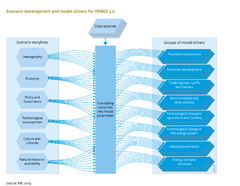Drivers: Difference between revisions
Jump to navigation
Jump to search
m (Text replace - "FrameworkElementType=driver" to "FrameworkElementType=driver component") |
No edit summary |
||
| Line 5: | Line 5: | ||
|Application=Millennium Ecosystem Assessment; | |Application=Millennium Ecosystem Assessment; | ||
|IMAGEComponent=Agriculture and land use; | |IMAGEComponent=Agriculture and land use; | ||
|ExternalModel=ENV-Growth; MAGNET model; | |ExternalModel=ENV-Growth; MAGNET model; | ||
|KeyReference=IPCC, 2000; OECD, 2012; MA, 2005; | |KeyReference=IPCC, 2000; OECD, 2012; MA, 2005; | ||
|Reference=Ten Brink et al., 2010; OECD, 2008a; UNEP, 2011; Westhoek et al., 2011; Aiking, 2011; Chateau, 2013 | |Reference=Ten Brink et al., 2010; OECD, 2008a; UNEP, 2011; Westhoek et al., 2011; Aiking, 2011; Chateau, 2013 | ||
| Line 12: | Line 12: | ||
For IMAGE, six groups of assumptions are distinguished that make up the scenario drivers. In this chapter these six scenario drivers will be described. These drivers are the basis of any scenario and are generally rooted in a scenario narrative or storyline. This includes cases where current trends and dynamics are assumed to continue into the future; commonly referred to as reference or ‘business-as-usual’ cases. As a rule, scenario drivers do not constitute numerical model inputs, but they do govern in qualitative or semi-quantitative terms the more elaborate set of exogenous assumptions in terms of model input files for the various parts of the model framework. In other words, numerical model drivers for any specific scenario will need to be established on the basis of the six more generic scenario drivers. The model drivers for the various modules are explained in more detail in the model components (these can be accessed via [[Components_Overview]]) . The scenario drivers and underlying narrative, together with the concrete quantitative model drivers form a scenario, inextricably linked with the results from the IMAGE scenario run. | For IMAGE, six groups of assumptions are distinguished that make up the scenario drivers. In this chapter these six scenario drivers will be described. These drivers are the basis of any scenario and are generally rooted in a scenario narrative or storyline. This includes cases where current trends and dynamics are assumed to continue into the future; commonly referred to as reference or ‘business-as-usual’ cases. As a rule, scenario drivers do not constitute numerical model inputs, but they do govern in qualitative or semi-quantitative terms the more elaborate set of exogenous assumptions in terms of model input files for the various parts of the model framework. In other words, numerical model drivers for any specific scenario will need to be established on the basis of the six more generic scenario drivers. The model drivers for the various modules are explained in more detail in the model components (these can be accessed via [[Components_Overview]]) . The scenario drivers and underlying narrative, together with the concrete quantitative model drivers form a scenario, inextricably linked with the results from the IMAGE scenario run. | ||
}} | }} | ||
Revision as of 13:32, 10 December 2013
| Projects/Applications |
| Models/Databases |
| Relevant overviews |
| Key publications |
